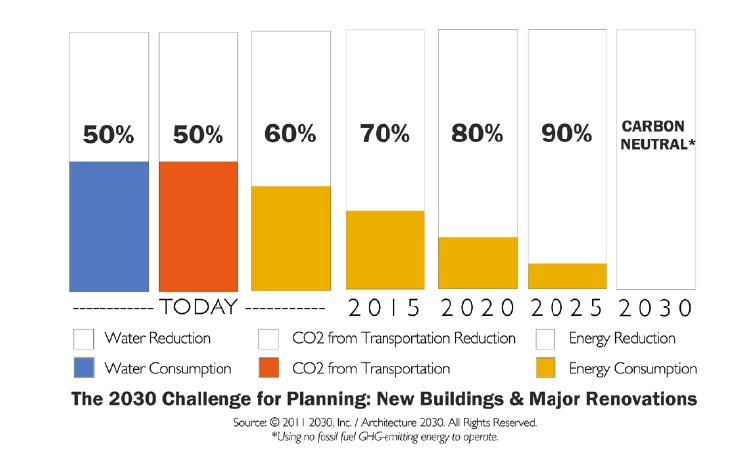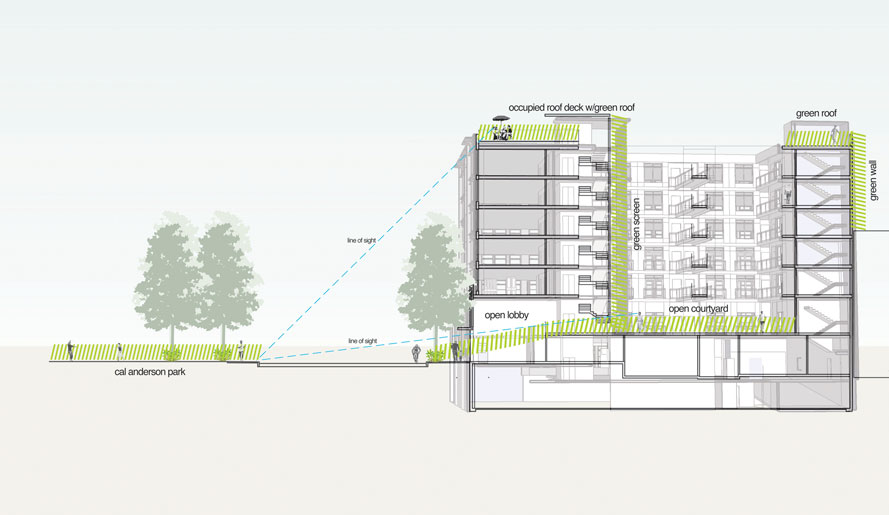Seattle is at the forefront when it comes to environmental awareness and green design. At Weber Thompson, we take these issues rather seriously. Our offices are LEED Platinum certified, our building, The Terry Thomas is LEED Gold certified, most of our projects are aiming for some level of LEED or other certifications, and we actively educate our clients about the benefits of building green. But despite the efforts on the part of our firm and others, heating, lighting, cooling and ventilation of buildings still accounts for approximately 40% of global carbon emissions, and construction of new buildings accounts for at least 10%. Clearly, something needs to change.
The Seattle 2030 District aims to tackle these issues at the core – more specifically, Seattle’s downtown core. An interdisciplinary public-private collaborative, the district has established a boundary that will eventually contain high-performance buildings that meet specific goals set by the Architecture 2030 Challenge for Planning. The goals are realistic and measurable, and target medium to large existing buildings and new construction projects that are privately owned within the district. By using a district approach to sustainability, rather than individual building approach, members can create partnerships and share resources while providing the opportunity for district-wide heat recovery, distributed generation, and other district efficiencies that can reduce demand for resources.
With many existing, under construction, and on-the-boards projects located within the district, it was natural for Weber Thompson to pursue membership in the organization. This week, we were awarded Founding Professional Stakeholder Membership status, and have agreed to commit in-kind hours annually, to educate clients about the district, and to encourage them to pursue membership in the district. Beyond that, we’ll share knowledge and resources and aim for all of our buildings within the boundary (including our offices) to meet the Seattle 2030 District goals. Speaking of goals, you might be asking yourself, “Okay, so what are the goals, anyway?” Well, here they are:
New construction:
- Energy Use: A minimum of 10% reduction below the National average by 2015 with incremental targets, reaching a 50% reduction by 2030
- Water Use: A minimum of 10% reduction below the District average by 2015 with incremental targets, reaching a 50% reduction by 2030.
- CO2 of Auto and Freight: A minimum of 10% reduction below the current District average by 2015 with incremental targets, reaching a 50% reduction by 2030.
Existing construction:
- Energy Use: An immediate 60% reduction below the National average with incremental targets, reaching carbon neutral by 2030.
- Water Use: An immediate 50% reduction below the current District Average.
- CO2 of Auto and Freight: An immediate 50% reduction below the current District Average.
How is Weber Thompson pursing these goals?
The most notable of our projects within the district is our mixed-use residential project in the Pike/Pine corridor, Sunset Electric. Here is an overview of why the project aligns so well with Seattle 2030:
- The goal of Sunset Electric is to be among the most energy efficient apartment buildings in the country
- The project is located at the intersection of 11th Ave E and E Pine Street, and is the first to be built under the Pike-Pine Character Building Ordinance, which grants an additional 10 feet of height to buildings that preserve an historic façade. This allows higher density while maintaining the neighborhood character at the street.
- The project will employ an innovative and efficient reverse cycle chiller system for domestic hot water, that taps into the stable temperatures of sub-grade parking
- Passive energy conservation such as natural cooling and natural daylighting will be used throughout
- An enhanced commissioning program will support energy-efficient operations after occupancy
- Low-flow fixtures are planned inside the building and water efficient irrigation, drought tolerant plants and a green roof are planned for the exterior
- Enclosed interior spaces (such as corridors) have been eliminated and replaced with a central courtyard, eliminating the largest typical heating load for buildings of this type and size
Involvement in the Seattle 2030 District is a win-win for everyone. We’re thrilled to participate in an innovative local approach to sustainability, and we’re also excited to work with existing and new clients who may otherwise not be aware of the benefits of participation. Because a major tenet of the district’s philosophy is achieving sustainability goals while also meeting financial goals, there are incentives for participants, which promote progress toward both. Complimentary building performance dashboards, access to grant funding and preferred purchasing discounts, training and support, and streamlined permitting services are some of the valuable incentives available to members.
To learn more about Seattle 2030 District or to get involved, visit www.2030district.org, or contact Myer Harrell, one of Weber Thompson’s in-house ‘green gurus’.

